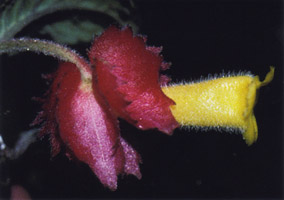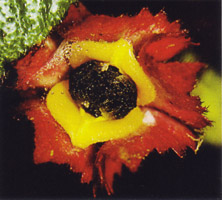

Gesneriads
56 (3): 23 (2006), phot.
J.L. Clark
Left: flower
Right: Fruit
Full name and orig. publication: Cranzia Scop., Introd. 173 (Jan.-April 1777).
Etymology: Named after Heinrich Johann Nepomuk Crantz (1722-1797), an acknowledged physician and botanist, born in the Duchy of Luxembourg and practising in Vienna under Empress Maria Theresia.
Synonyms: Lophia Desv. (1825), nom. illeg., Lophalix Raf. (1838), Heintzia Karst. (1848), Prionoplectus Oerst. (1858).
Infrafamilial position: Gesnerioid Gesneriaceae (Gesnerioideae) - Episcieae.
Description: Epiphytic or terrestrial subshrubs or coarse herbs with fibrous roots. Stems terete or quadrangular, richly branched. Leaves opposite, ± isophyllous, petiolate, lamina elliptic to ovate, margin entire or serrate. Cymes axillary, few-flowered, bracteolate. Flowers resupinate (except C. tigrina). Sepals nearly free, green or colored, broadly ovate, entire to strongly serrate, pubescent or pilose. Corolla oblique to horizontal in the calyx, tubular, yellow or red, not puched, limb of usually 5 small lobes. Stamens 4, included; filaments adnate to base of corolla tube; anthers transversely oblong, coherent or becoming free, dehiscing by longitudinal slits. Nectary a 2-lobed (rarely single-lobed) gland. Ovary superior, style included. Fruit a fleshy bivalved capsule surrounded by the persistent calyx. Seeds numerous, longitudinally striate.
Chromosome number: 2n = 18.
Species number: 4.
Species names (incl. publication and synonyms): See Skog, L.E. & J.K. Boggan. 2005: World checklist of Gesneriaceae: http://persoon.si.edu/Gesneriaceae/Checklist.
Type species: Crantzia cristata (L.) Scop. ex Fritsch
Distribution: Mainly in the Carribean, one sp. in Venzuela, one on the Guiana Shield.
Ecology: Epiphytic climbers, or terrestrials; growing in moist and wet forests.
Notes: Essentially based on molecular data, Crantzia was recently re-established by J.L. Clark (see Clark 2005, Clark et al. 2006) for four species traditionally referred to Alloplectus. Like in Glossoloma, the flowers are [with the exception of C. tigrina (Karst.) Fritsch] resupinate (upside-down-orientation).. Other characteristic features include terrestrial habit, ± isophyllous leaves, terminally pouched flowers, longitudinal dehiscence of the anthers and fleshy capsules. The genus is related to Alloplectus, Glossoloma, Drymonia and Columnea s.l. A revision of Crantzia is in preparation (J.L. Clark, pers. comm.). Two species are in cultivation: C. cristata (L.) Scop. ex Fritsch and C. epirotes (Leeuwenb.) J.L.Clark.
Selected references: Clark, Selbyana 25: 182-209 (2005), rev. of Alloplectus; Clark, Herendeen, Skog, Zimmer, Taxon 55: 313-336 (2006), molec. syst.; Clark, Gesneriads 56(3): 20-25 (2006), surv.;
Bibliography: See Skog, L.E. & J.K. Boggan. 2005. Bibliography of the Gesneriaceae. 2nd edition: http://persoon.si.edu/Gesneriaceae/Bibliography.
Illustrations:
 |
 |
Crantzia
cristata (L.) Scop. ex Fritsch, type species
Gesneriads
56 (3): 23 (2006), phot.
J.L. Clark |
last modified: 2007-01-05